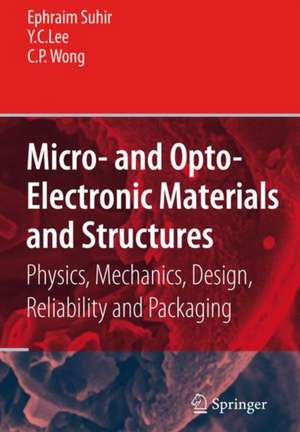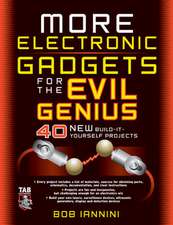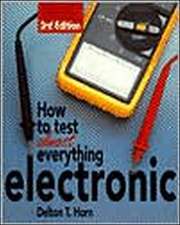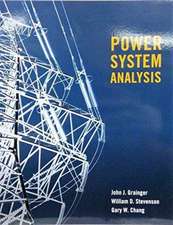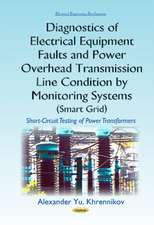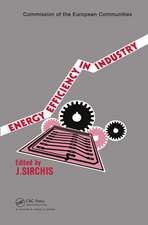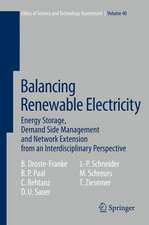Micro- and Opto-Electronic Materials and Structures: Physics, Mechanics, Design, Reliability, Packaging: Volume I Materials Physics - Materials Mechanics. Volume II Physical Design - Reliability and Packaging
Editat de Ephraim Suhir, Y.C. Lee, C.P. Wongen Limba Engleză Hardback – 29 mai 2007
Volume I focuses on physics and mechanics of micro- and opto-electronic structures and systems, i.e., on the science underpinnings of engineering methods and approaches used in microelectronics and photonics. Volume II deals with various practical aspects of reliability and packaging of micro- and opto-electronic systems. Internationally recognized experts and world leaders in particular areas of this branch of applied science and engineering contributed to the book.
| Toate formatele și edițiile | Preț | Express |
|---|---|---|
| Paperback (1) | 2671.19 lei 38-44 zile | |
| Springer Us – 23 aug 2016 | 2671.19 lei 38-44 zile | |
| Hardback (1) | 2726.02 lei 38-44 zile | |
| Springer Us – 29 mai 2007 | 2726.02 lei 38-44 zile |
Preț: 2726.02 lei
Preț vechi: 3586.87 lei
-24% Nou
Puncte Express: 4089
Preț estimativ în valută:
521.61€ • 546.08$ • 431.61£
521.61€ • 546.08$ • 431.61£
Carte tipărită la comandă
Livrare economică 03-09 aprilie
Preluare comenzi: 021 569.72.76
Specificații
ISBN-13: 9780387279749
ISBN-10: 0387279741
Pagini: 1460
Ilustrații: LXII, 1460 p. In 2 volumes, not available separately.
Dimensiuni: 178 x 254 x 73 mm
Greutate: 3.43 kg
Ediția:2007
Editura: Springer Us
Colecția Springer
Locul publicării:New York, NY, United States
ISBN-10: 0387279741
Pagini: 1460
Ilustrații: LXII, 1460 p. In 2 volumes, not available separately.
Dimensiuni: 178 x 254 x 73 mm
Greutate: 3.43 kg
Ediția:2007
Editura: Springer Us
Colecția Springer
Locul publicării:New York, NY, United States
Public țintă
ResearchCuprins
Materials Physics.- Polymer Materials Characterization, Modeling and Application.- Thermo-Optic Effects in Polymer Bragg Gratings.- Photorefractive Materials and Devices for Passive Components in WDM Systems.- Thin Films for Microelectronics and Photonics: Physics, Mechanics, Characterization, and Reliability.- Carbon Nanotube Based Interconnect Technology: Opportunities and Challenges.- Virtual Thermo-Mechanical Prototyping of Microelectronics and Microsystems.- Materials Mechanics.- Fiber Optics Structural Mechanics and Nano-Technology Based New Generation of Fiber Coatings: Review and Extension.- Area Array Technology for High Reliability Applications.- Metallurgical Factors Behind the Reliability of High-Density Lead-Free Interconnections.- Metallurgy, Processing and Reliability of Lead-Free Solder Joint Interconnections.- Fatigue Life Assessment for Lead-Free Solder Joints.- Lead-Free Solder Materials: Design For Reliability.- Application of Moire Interferometry to Strain Analysis of PCB Deformations at Low Temperatures.- Characterization of Stresses and Strains in Microelectronics and Photonics Devices Using Photomechanics Methods.- Analysis of Reliability of IC Packages Using the Fracture Mechanics Approach.- Dynamic Response of Micro- and Opto-Electronic Systems to Shocks and Vibrations: Review and Extension.- Dynamic Physical Reliability in Application to Photonic Materials.- High-Speed Tensile Testing of Optical Fibers— New Understanding for Reliability Prediction.- The Effect of Temperature on the Microstructure Nonlinear Dynamics Behavior.- Effect of Material’s Nonlinearity on the Mechanical Response of some Piezoelectric and Photonic Systems.- Physical Design.- Analytical Thermal Stress Modeling in Physical Design for Reliability of Micro- andOpto-Electronic Systems: Role, Attributes, Challenges, Results.- Probabilistic Physical Design of Fiber-Optic Structures.- The Wirebonded Interconnect: A Mainstay for Electronics.- Metallurgical Interconnections for Extreme High and Low Temperature Environments.- Design, Process, and Reliability of Wafer Level Packaging.- Passive Alignment of Optical Fibers in V-grooves with Low Viscosity Epoxy Flow.- Reliability and Packaging.- Fundamentals of Reliability and Stress Testing.- How to Make a Device into a Product: Accelerated Life Testing (ALT), Its Role, Attributes, Challenges, Pitfalls, and Interaction with Qualification Tests.- Micro-Deformation Analysis and Reliability Estimation of Micro-Components by Means of NanoDAC Technique.- Interconnect Reliability Considerations in Portable Consumer Electronic Products.- MEMS Packaging and Reliability.- Advances in Optoelectronic Methodology for MOEMS Testing.- Durability of Optical Nanostructures: Laser Diode Structures and Packages, A Case Study.- Review of the Technology and Reliability Issues Arising as Optical Interconnects Migrate onto the Circuit Board.- Adhesives for Micro- and Opto-Electronics Application: Chemistry, Reliability and Mechanics.- Multi-Stage Peel Tests and Evaluation of Interfacial Adhesion Strength for Micro- and Opto-Electronic Materials.- The Effect of Moisture on the Adhesion and Fracture of Interfaces in Microelectronic Packaging.- Highly Compliant Bonding Material for Micro- and Opto-Electronic Applications.- Adhesive Bonding of Passive Optical Components.- Electrically Conductive Adhesives: A Research Status Review.- Electrically Conductive Adhesives.- Recent Advances of Conductive Adhesives: A Lead-Free Alternative in Electronic Packaging.- Die Attach Quality Testing by StructureFunction Evaluation.- Mechanical Behavior of Flip Chip Packages under Thermal Loading.- Stress Analysis for Processed Silicon Wafers and Packaged Micro-devices.
Recenzii
From the reviews:
"The book contains 25 chapters written by experts, mainly drawn from the United States and Europe. The chapters contain good technical details and thorough reference lists, and most of the figures are high quality. … For those engaged in developing MOEMS products and similar activities, the acquisition of this book … will be a sound investment." (K. Alan Shore, Optics and Photonics News, November, 2007)
"The book contains 25 chapters written by experts, mainly drawn from the United States and Europe. The chapters contain good technical details and thorough reference lists, and most of the figures are high quality. … For those engaged in developing MOEMS products and similar activities, the acquisition of this book … will be a sound investment." (K. Alan Shore, Optics and Photonics News, November, 2007)
Notă biografică
Dr. Ephraim Suhir is Distinguished Member of Technical Staff (retired), Basic Research, Physical Sciences and Engineering Research Division, Bell Labs, Murray Hill, NJ. He is currently on the faculty of the Electrical Engineering Department, University of California, Santa Cruz, CA and the Department of Mechanical Engineering, University of Maryland, College Park, MD. Dr. Suhir is Fellow of the American Physical Society (APS), the Institute of Electrical and Electronics Engineers (IEEE), the American Society of Mechanical Engineers (ASME), and the Society of Plastics Engineers (SPE). He is co-founder (with Dr. Peter Engel) of the ASME Journal of Electronic Packaging and served as its Technical Editor for eight years (1993-2001). He has received numerous distinguished service and professional awards, including 2004 ASME Worcester Read Warner Medal for outstanding contributions to the permanent literature of engineering; 2001 IMAPS John A. Wagnon Technical Achievement Award for outstanding contributions to the technical knowledge of the microelectronics, optoelectronics, and packaging industry; 2000 IEEE-CPMT Outstanding Sustained Technical Contribution Award for outstanding, sustained and continuing contributions to the technologies in fields encompassed by the CPMT Society; 2000 SPE International Engineering/Technology (Fred O. Conley) Award for outstanding pioneering and continuing contributions to plastics engineering; and 1999 ASME and Pi-Tau-Sigma Charles Russ Richards Memorial Award for outstanding contributions to mechanical engineering.
Prof. C. P. Wong is a Regents’ Professor and the Charles Smithgall Institute Endowed Chair at the School of Materials Science and Engineering at Georgia Institute of technology. After his doctoral study, he was awarded a two-year postdoctoral fellowship with Nobel Laureate Professor Henry Taube at Stanford University. He joined AT&T BellLaboratories in 1977 as a member of the technical staff and in 1992, he was elected as an AT&T Bell Laboratories Fellow for his fundamental contributions to low-cost high performance plastic packaging of semiconductors. Since 1996, he is a Professor at the School of Materials Science and Engineering at the Georgia Institute of Technology. He has received many awards, among those, the AT&T Bell Labs Fellow Award in 1992, the IEEE CPMT Society Outstanding and Best Paper Awards in 1990, 1991, 1994, 1996, 1998, 2002, the IEEE CPMT Society Outstanding Sustained Technical Contributions Award in 1995, the IEEE Third Millennium Medal in 2000, the IEEE EAB Education Award in 2001, the IEEE CPMT Society Exceptional Technical Contributions Award in 2002 and the IEEE Components, Packaging and Manufacturing Technology Field Award in 2006. Dr. Wong is a Fellow of the IEEE, AIC, and AT&T Bell Labs, and was the technical vice president (1990 &1991), and the president of the IEEE-CPMT Society (1992 &1993). He was elected a member of the National Academy of Engineering in 2000.
Professor Y. C. Lee is a Professor of Mechanical Engineering. He was the Chair of ASME Electronic and Photonic Packaging Division (EPPD) from 2004 to 2005. From 1993 to 2002, he was an Associate Director of the Center for Advanced Manufacturing and Packaging of Microwave, Optical and Digital Electronics, University of Colorado at Boulder. Prior to joining the University in 1989, he was a Member of Technical Staff at AT&T Bell Laboratories, Murray Hill, New Jersey. Dr. Lee was an Associated Editor of ASME Journal of Electronic Packaging from 2001 to 2004 and a Guest Editor for IEEE Transaction on Advanced Packaging in 2003 and 2005. He has received several awards: ASME Fellow, December 2002, Presidential Young Investigator (National Science Foundation, 1990), Outstanding Young Manufacturing Engineer Award (SME, 1992), Outstanding Paper Award (IEEE-ECTC, 1991), Outstanding Paper Award (ASME J. of Electronic Packaging, 1993), IEEE Transactions on Advanced Packaging Honorable Mention Paper Award, 2003
Prof. C. P. Wong is a Regents’ Professor and the Charles Smithgall Institute Endowed Chair at the School of Materials Science and Engineering at Georgia Institute of technology. After his doctoral study, he was awarded a two-year postdoctoral fellowship with Nobel Laureate Professor Henry Taube at Stanford University. He joined AT&T BellLaboratories in 1977 as a member of the technical staff and in 1992, he was elected as an AT&T Bell Laboratories Fellow for his fundamental contributions to low-cost high performance plastic packaging of semiconductors. Since 1996, he is a Professor at the School of Materials Science and Engineering at the Georgia Institute of Technology. He has received many awards, among those, the AT&T Bell Labs Fellow Award in 1992, the IEEE CPMT Society Outstanding and Best Paper Awards in 1990, 1991, 1994, 1996, 1998, 2002, the IEEE CPMT Society Outstanding Sustained Technical Contributions Award in 1995, the IEEE Third Millennium Medal in 2000, the IEEE EAB Education Award in 2001, the IEEE CPMT Society Exceptional Technical Contributions Award in 2002 and the IEEE Components, Packaging and Manufacturing Technology Field Award in 2006. Dr. Wong is a Fellow of the IEEE, AIC, and AT&T Bell Labs, and was the technical vice president (1990 &1991), and the president of the IEEE-CPMT Society (1992 &1993). He was elected a member of the National Academy of Engineering in 2000.
Professor Y. C. Lee is a Professor of Mechanical Engineering. He was the Chair of ASME Electronic and Photonic Packaging Division (EPPD) from 2004 to 2005. From 1993 to 2002, he was an Associate Director of the Center for Advanced Manufacturing and Packaging of Microwave, Optical and Digital Electronics, University of Colorado at Boulder. Prior to joining the University in 1989, he was a Member of Technical Staff at AT&T Bell Laboratories, Murray Hill, New Jersey. Dr. Lee was an Associated Editor of ASME Journal of Electronic Packaging from 2001 to 2004 and a Guest Editor for IEEE Transaction on Advanced Packaging in 2003 and 2005. He has received several awards: ASME Fellow, December 2002, Presidential Young Investigator (National Science Foundation, 1990), Outstanding Young Manufacturing Engineer Award (SME, 1992), Outstanding Paper Award (IEEE-ECTC, 1991), Outstanding Paper Award (ASME J. of Electronic Packaging, 1993), IEEE Transactions on Advanced Packaging Honorable Mention Paper Award, 2003
Textul de pe ultima copertă
Micro- and Opto-Electronic Materials and Structures: Physics, Mechanics, Design, Reliability, Packaging is the first comprehensive reference to collect and present the most, up-to-date, in-depth, practical and easy-to-use information on the physics, mechanics, reliability and packaging of micro- and opto-electronic materials, assemblies, structures and systems. The chapters in these two volumes contain summaries of the state-of-the-art and present new information on recently developed important methods or devices. Furthermore, practical recommendations are offered on how to successfully apply current knowledge and recently developed technology to design, manufacture and operate viable, reliable and cost-effective electronic components or photonic devices. The emphasis is on the science and engineering of electronic and photonic packaging, on physical design problems, challenges and solutions.
Volume I focuses on physics and mechanics of micro- and opto-electronic structures and systems, i.e., on the science underpinnings of engineering methods and approaches used in microelectronics and photonics. Volume II deals with various practical aspects of reliability and packaging of micro- and opto-electronic systems. Internationally recognized experts and world leaders in particular areas of this branch of applied science and engineering contributed to the book.
Topics addressed in the book include, but are not limited to, the following:
physics and mechanics of polymer materials;
underfills;
electrically conductive adhesives;
plastic packages of IC devices;
flip-chip packages;
wirebond interconnects and metallurgical interconnections for harsh environments;
reliability and stress testing and accelerated life testing;
solder joint materials and technologies as wellas lead-free solder materials and joints;
reliability of mobile electronic products, photonic materials, optical fibers and active and passive optical components;
thermal phenomena in micro- and opto-electronic systems and thermal stresses;
adhesion problems and solutions;
thin film materials, physics and mechanics;
photorefractive materials and devices;
nanomaterials and nanotechnology;
multiphysics modeling and optimization technologies;
experimental methods and techniques;
testing methods and techniques, subjected to thermal loading, stress analyses of processed silicon wafers, and many others.
The book is intended as a reference source and as a manual for electrical, materials, mechanical, and reliability engineers, as well as applied physicists and materials scientists. The book will be an essential tool for all those who are involved or interested in state-of-the-art in the analysis, design and manufacturing of micro- and opto-electronic systems.
Volume I focuses on physics and mechanics of micro- and opto-electronic structures and systems, i.e., on the science underpinnings of engineering methods and approaches used in microelectronics and photonics. Volume II deals with various practical aspects of reliability and packaging of micro- and opto-electronic systems. Internationally recognized experts and world leaders in particular areas of this branch of applied science and engineering contributed to the book.
Topics addressed in the book include, but are not limited to, the following:
physics and mechanics of polymer materials;
underfills;
electrically conductive adhesives;
plastic packages of IC devices;
flip-chip packages;
wirebond interconnects and metallurgical interconnections for harsh environments;
reliability and stress testing and accelerated life testing;
solder joint materials and technologies as wellas lead-free solder materials and joints;
reliability of mobile electronic products, photonic materials, optical fibers and active and passive optical components;
thermal phenomena in micro- and opto-electronic systems and thermal stresses;
adhesion problems and solutions;
thin film materials, physics and mechanics;
photorefractive materials and devices;
nanomaterials and nanotechnology;
multiphysics modeling and optimization technologies;
experimental methods and techniques;
testing methods and techniques, subjected to thermal loading, stress analyses of processed silicon wafers, and many others.
The book is intended as a reference source and as a manual for electrical, materials, mechanical, and reliability engineers, as well as applied physicists and materials scientists. The book will be an essential tool for all those who are involved or interested in state-of-the-art in the analysis, design and manufacturing of micro- and opto-electronic systems.
Caracteristici
Most up-to-date, in-depth, practical and easy-to-use information on micro- and opto-electronic materials, assemblies, structures and systems Practical recommendations are offered on how to successfully apply current knowledge Treatment of recently developed technology to design, manufacture and operate viable, reliable and cost-effective electronic components or photonic devices Written by the best specialists in the field Includes supplementary material: sn.pub/extras
